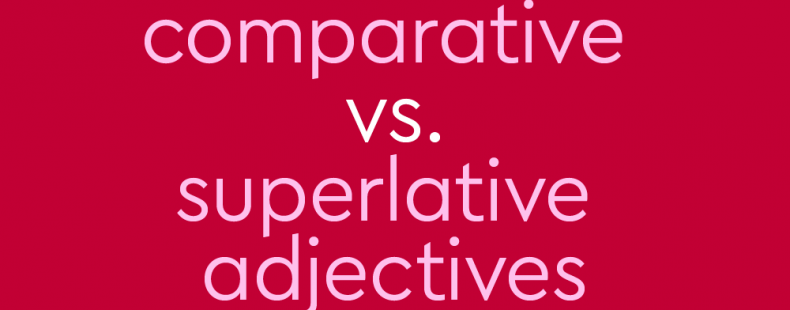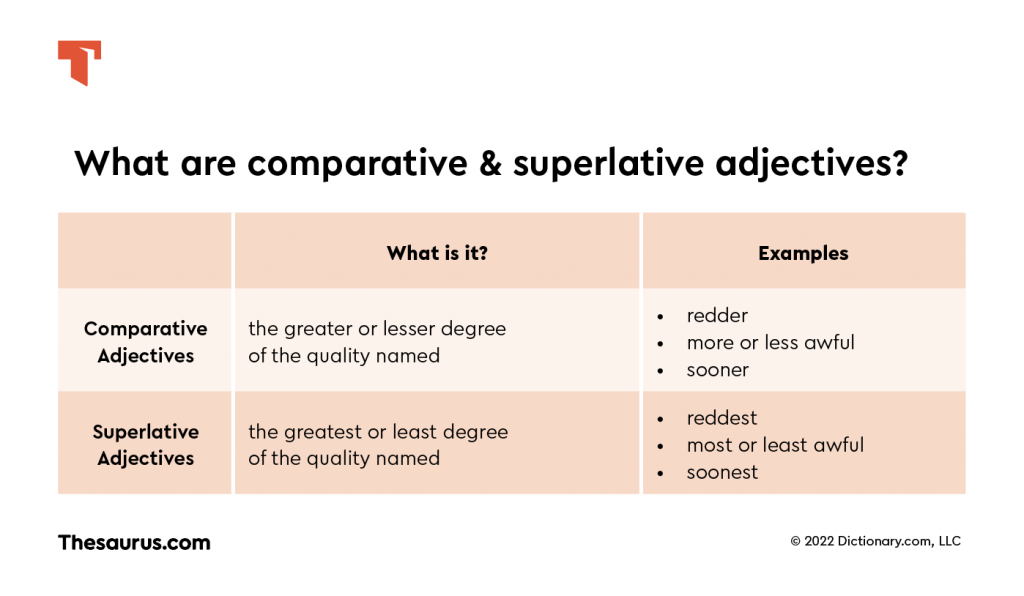When we describe the things around us, we often make comparisons. For example, a lion is a big cat. When we see a rhino sitting next to a lion, we might say that the rhino is bigger than the lion due to its size. Later on during our safari, we see an elephant, and we know that it is the biggest animal we are likely to see due to its massive size.
If you’re the king of the grammar jungle, you already know that we use adjectives like the words big, bigger, and biggest to modify and describe nouns and pronouns. When we make comparisons, we use special types of adjectives called comparative adjectives and superlative adjectives. But what is the difference between these two? Is one better than the other? And which kind of adjective is best to use in our sentences? We can’t settle this adjective popularity contest right now but we can compare these two types of adjectives to learn when and how to use them.

Comparative adjective vs. superlative adjective
Both comparative adjectives and superlative adjectives are formed from the positive form of an adjective (the “basic” form you’ll see if you look up an adjective in our amazing dictionary). In general, comparative adjectives end in -er or use the words more or less, while superlative adjectives end in -est or use the words most and least. For example, smaller is a comparative adjective and smallest is a superlative adjective. As another example, more determined is a comparative adjective and most determined is a superlative adjective.
Both of these types of adjectives are used in comparisons of people and/or things. Comparative adjectives are used to compare two people or things and superlative adjectives are used to compare more than two people or things. For example:
- My house is bigger than her house. (comparing two things)
- Out of the 30 houses in the neighborhood, Reginald’s is the biggest. (comparing more than two things)
- Maya is younger than Ben. (comparing two people)
- Maya is the youngest student in the class of 20. (comparing more than two people)
We will explore more specific ways that we use comparative and superlative adjectives later, but this is the main difference to keep in mind between these two types of adjectives.
Comparative adjective
Let’s first take a look at examples of comparative adjectives and how we use them in sentences.
List of comparative adjectives
As long as it makes sense to compare a certain quality, almost any positive form adjective can become a comparative adjective. Listed below are just some examples of comparative adjectives:
- angstier, more beautiful, less careful, darker, easier, faster, grumpier, hotter, icier, more jumbled, less knowledgeable, looser, messier, nicer, odder, more pleasing, less questionable, redder, spookier, tinier, uglier, vaster, wobblier, younger, zestier
Examples of comparative adjectives in a sentence
In the following sentences, the comparative adjective is in bold.
- The weather is cloudier today than it was yesterday.
- My car is nice, but hers is much nicer.
- For many students, learning calculus is significantly harder than learning algebra.
- Ishan is my younger brother.
- A feather is lighter than a bowling ball.
Learn everything you need to know about comparative adjectives here.
Superlative adjective
Now, let’s look at examples of superlative adjectives and how we use them in sentences.
List of superlative adjectives
Just like comparative adjectives, superlative adjectives can be formed from almost any positive form adjective as long as it makes sense to compare the quality that the adjective is referring to. You can see this is in the following examples that are based on the same positive form adjectives that we used to form comparative adjectives earlier:
- angstiest, most beautiful, least careful, darkest, easiest, fastest, grumpiest, hottest, iciest, most jumbled, least knowledgeable, loosest, messiest, nicest, oddest, most pleasing, least questionable, reddest, spookiest, tiniest, ugliest, vastest, wobbliest, youngest, zestiest
Examples of superlative adjectives in a sentence
In the following sentences, the superlative adjective is written in bold.
- When you compare cheetahs, lions, and tigers, the cheetahs are clearly the fastest.
- Out of the 50 books I own, this one is the longest.
- In my opinion, George Washington was America’s greatest president.
- My yard is big, Mike’s is bigger, and Felicia’s is the biggest of the three.
- I have had a lot of dumb ideas, but my plan to open a shark nursery was by far the dumbest.
Become the best at understanding superlative adjectives by reviewing this article.
Irregular adjectives
There are some adjectives that act differently when it comes to using them as comparative and superlative adjectives.
Some adjectives can use either the -er or -est ending or the words more/most/less/least. Some examples include the adjectives quiet, narrow, clever, and yellow. When using these adjectives, either method is acceptable but you must not use both at the same time. For example, a motor can be said to be quieter or more quiet but not “more quieter.”
A few adjectives just don’t follow the rules at all. These include the words good, well, bad, old, and far. Listed below are the comparative and superlative forms of these irregular adjectives:
- good and well → better (comparative) and best (superlative)
- bad → worse (comparative) and worst (superlative). Sometimes, the words badder and baddest are used as slang or nonstandard comparative and superlative forms of bad.
- old → For the most part, the words older and oldest are used as the comparative and superlative forms of old. However, some style guides may prefer to use the words elder and eldest when comparing the ages of people. In general speech and writing, though, the words older and oldest are commonly used even when referring to people.
- far → farther/further (comparative) and farthest/furthest (superlative). Style guides will often state that it is preferred to use farther/farthest when referring to physical distances and further/furthest when referring to figurative distances. However, this distinction is usually ignored in everyday speech and writing, and these words are commonly used interchangeably.
When to use comparative and superlative adjectives?
As stated earlier, the general rule is that we use comparative adjectives to compare two people or things and superlative adjectives to compare more than two peopler things:
- A husky is larger than a Chihuahua. (comparing two things)
- The husky was the largest of the 10 dogs at the park. (comparing more than two things)
If something or someone is generally being compared to every other member of their group, we use a superlative adjective:
- The tower was the largest building that the company ever built.
- Out of all of the meats, I think pepperoni is the yummiest.
You need to be careful with plural nouns or words/phrases that are collectively referring to a group as a single entity. Even if a word is referring to multiple people or things, we still use a comparative adjective if we are comparing exactly two distinct items, groups, or categories. For example:
- I think that apples are tastier than oranges. (In this sentence, the words apples and oranges are used to refer to types of fruit. Because we are still comparing exactly two things, we use a comparative adjective.)
- Alaska is larger than many European countries. (In this sentence, the phrase many European countries is treated as one single collective group. Even though Alaska is being compared to multiple countries, we are still grammatically only comparing two distinct things and so we use a comparative adjective.)
You also need to watch out for sentences that use conjunctions. Often, conjunctions are used to link multiple comparisons together. Even in this case, we often still use a comparative conjunction. For example,
- Angela is shorter than Bob, Clint, and Hana.
Why do we use a comparative adjective in the above sentence even though we are clearly talking about more than two people? Take a second to read the sentence again and look closely at what it is actually saying. This sentence uses the conjunction and to link three different comparisons together: rather than comparing the four people to each other, we are actually comparing Angela to one other person three times. If we wanted to use a superlative adjective instead, we could rewrite the sentence without using a conjunction so that we compare all four people to each other:
- Angela is the shortest person out of her circle of friends, which includes herself, Bob, Clint, and Hana.
One last thing to keep in mind is that you might see comparative and superlative adjectives used interchangeably in idiomatic expressions. For example, look at the following two sentences:
- A hippo is one of the largest animals you will find in the savannah.
- A hippo is one of the larger animals you will find in the savannah.
Do they sound right to you? Probably! And yet, grammatically, the first is considered a nonstandard use because it isn’t possible for there to be multiple “largest animals.” Either a group of animals is the largest or it isn’t. However, you are likely to see sentences similar to the first example used both in writing and speech. It has the exact same meaning as the second sentence, but it stylistically places a greater emphasis on the size and bulk of a hippo than the second sentence does.
Are you the best at comparative and superlative adjectives? Take this quiz to find out!
You’ll be better than the best with Grammar Coach™
We aren’t your average spell check. The Thesaurus.com Grammar Coach™ platform makes writing papers, essays, emails, and a whole lot more a whole lot easier. Its Synonym Swap will find the best nouns, adjectives, comparatives, superlatives, and more to help say what you really mean, guiding you toward clearer, stronger, writing. Start writing smarter today!















